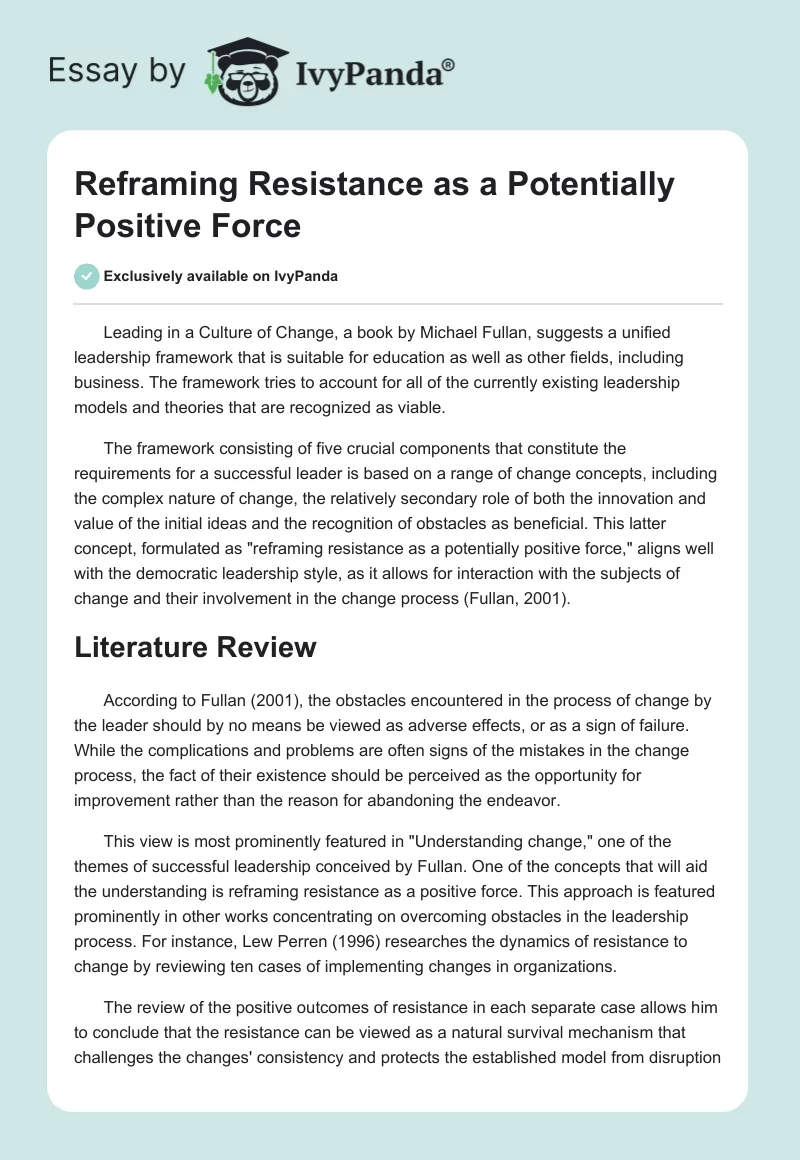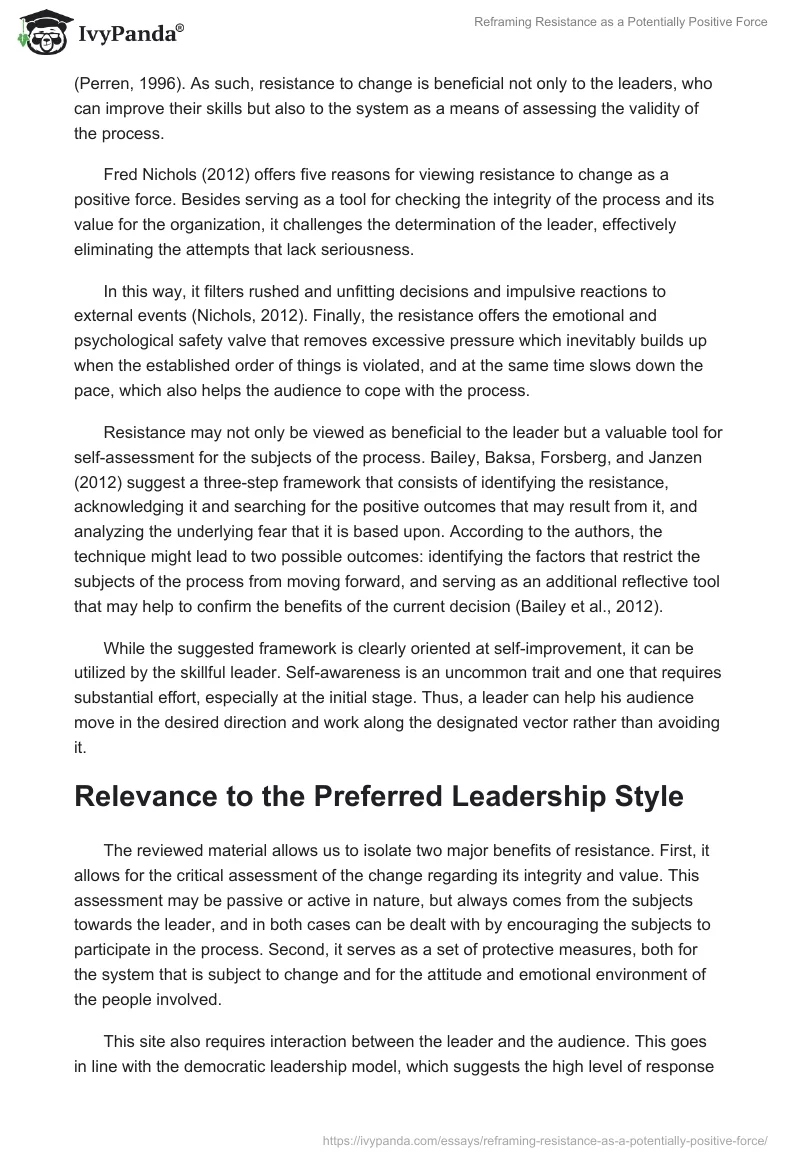Leading in a Culture of Change, a book by Michael Fullan, suggests a unified leadership framework that is suitable for education as well as other fields, including business. The framework tries to account for all of the currently existing leadership models and theories that are recognized as viable.
The framework consisting of five crucial components that constitute the requirements for a successful leader is based on a range of change concepts, including the complex nature of change, the relatively secondary role of both the innovation and value of the initial ideas and the recognition of obstacles as beneficial. This latter concept, formulated as “reframing resistance as a potentially positive force,” aligns well with the democratic leadership style, as it allows for interaction with the subjects of change and their involvement in the change process (Fullan, 2001).
Literature Review
According to Fullan (2001), the obstacles encountered in the process of change by the leader should by no means be viewed as adverse effects, or as a sign of failure. While the complications and problems are often signs of the mistakes in the change process, the fact of their existence should be perceived as the opportunity for improvement rather than the reason for abandoning the endeavor.
This view is most prominently featured in “Understanding change,” one of the themes of successful leadership conceived by Fullan. One of the concepts that will aid the understanding is reframing resistance as a positive force. This approach is featured prominently in other works concentrating on overcoming obstacles in the leadership process. For instance, Lew Perren (1996) researches the dynamics of resistance to change by reviewing ten cases of implementing changes in organizations.
The review of the positive outcomes of resistance in each separate case allows him to conclude that the resistance can be viewed as a natural survival mechanism that challenges the changes’ consistency and protects the established model from disruption (Perren, 1996). As such, resistance to change is beneficial not only to the leaders, who can improve their skills but also to the system as a means of assessing the validity of the process.
Fred Nichols (2012) offers five reasons for viewing resistance to change as a positive force. Besides serving as a tool for checking the integrity of the process and its value for the organization, it challenges the determination of the leader, effectively eliminating the attempts that lack seriousness.
In this way, it filters rushed and unfitting decisions and impulsive reactions to external events (Nichols, 2012). Finally, the resistance offers the emotional and psychological safety valve that removes excessive pressure which inevitably builds up when the established order of things is violated, and at the same time slows down the pace, which also helps the audience to cope with the process.
Resistance may not only be viewed as beneficial to the leader but a valuable tool for self-assessment for the subjects of the process. Bailey, Baksa, Forsberg, and Janzen (2012) suggest a three-step framework that consists of identifying the resistance, acknowledging it and searching for the positive outcomes that may result from it, and analyzing the underlying fear that it is based upon. According to the authors, the technique might lead to two possible outcomes: identifying the factors that restrict the subjects of the process from moving forward, and serving as an additional reflective tool that may help to confirm the benefits of the current decision (Bailey et al., 2012).
While the suggested framework is clearly oriented at self-improvement, it can be utilized by the skillful leader. Self-awareness is an uncommon trait and one that requires substantial effort, especially at the initial stage. Thus, a leader can help his audience move in the desired direction and work along the designated vector rather than avoiding it.
Relevance to the Preferred Leadership Style
The reviewed material allows us to isolate two major benefits of resistance. First, it allows for the critical assessment of the change regarding its integrity and value. This assessment may be passive or active in nature, but always comes from the subjects towards the leader, and in both cases can be dealt with by encouraging the subjects to participate in the process. Second, it serves as a set of protective measures, both for the system that is subject to change and for the attitude and emotional environment of the people involved.
This site also requires interaction between the leader and the audience. This goes in line with the democratic leadership model, which suggests the high level of response to the reactions by the group (Saxena, 2009). Besides, democratic leadership requires a timely and appropriate response to critique, which also is inherent to the reviewed change concept. Finally, the democratic leadership presumes the possibility of the uncertainty and possible flawed techniques to be addressed by the group, which also aligns well with the concept in question.
Concept of Change Description
Purpose
The resistance is a predictable reaction to changing an established order. While it may hamper the progress and present additional difficulties, when addressed appropriately it may not only yield positive insights but turn the situation in favor of the leader.
Historical and Political Perspective
Positive outcomes of resistance have been studied since the introduction of the transformational leadership theory in the seventies and have been conclusively established in the 1996 study by Lew Perren.
Structure and Methodology
The concept of recognizing resistance as a positive force is an integral part of the “Understanding Change,” a theme within the leadership framework. The latter along with four others (moral purpose, relationship building, knowledge creation, and sharing, and coherence making) forms the initial core, supported by the three personal characteristics (hope, enthusiasm, and energy). This core is used to mobilize the subject’s external and, gradually, internal commitment to achieve good ad avoid bad outcomes.
Strengths and Weakness
The obvious strengths of the concept are self-improvement resulting from the constant challenge of change and the possibility of controlling the pace and emotional climate of the group. The weaknesses are the decreased productivity in the cases when the subjects hamper the change process regardless of its actual value in the case when democratic leadership is executed poorly and is substituted with the lassies-fair approach.
Applications
The concept is applicable in education when dealing with new programs as well as changes in structure or advancing to new levels. Alternatively, it may be used in a wide variety of organizations, including the business sector.
Process for Implementation
Traditionally, the process involves the review of the reason behind the resistance, isolating the relevant ones, and addressing them in two ways. The reasons that indicate the inconsistencies in the process should be discussed and acceptable alternatives should be sought and implemented; the ones that are habitual in nature should also be brought to light and dealt with in order to show their benefits over the existing state of events.
References
Bailey, P., Baksa, G., Forsberg, S., & Janzen, C. (2012). Resistance to change – why it’s good and how to use it. Web.
Fullan, M. (2001). Leading in a culture of change. San Francisco, CA: John Wiley and Sons.
Nichols, F. (2012). Embracing resistance to change. Web.
Perren, L. (1996). Resistance to change as a positive force: its dynamics and issues for management development. Career Development International, 1(4), 24-28.
Saxena, P. (2009). Principles of management: a modern approach. New Dehli, India: Global India Publications.


